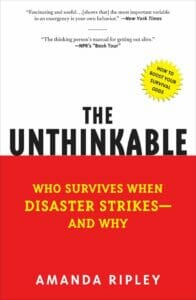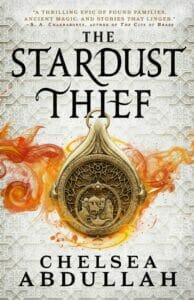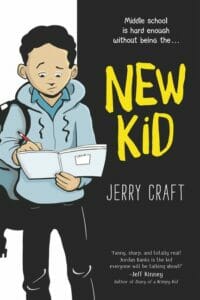ReadMHK and Past K-State First Books
Jennifer Jordan, Adult Services Librarian
 With classes started, swarms of people walking through campus, and Aggieville being in full swing, we get to welcome back K-State students. As the class of 2026 joins the Manhattan community, they also join their fellow classmates in reading this year’s K-State First Book, “The Unthinkable” by Amanda Ripley. Her book investigates the people who survive disasters and tragedies with stories of survivors and research of how the brain works.
With classes started, swarms of people walking through campus, and Aggieville being in full swing, we get to welcome back K-State students. As the class of 2026 joins the Manhattan community, they also join their fellow classmates in reading this year’s K-State First Book, “The Unthinkable” by Amanda Ripley. Her book investigates the people who survive disasters and tragedies with stories of survivors and research of how the brain works.
K-State First Book’s success helped inspire Manhattan Public Library’s ReadMHK program, which begins Sept. 1st. ReadMHK will kick off by encouraging our patrons and the community to join K-State students in reading “The Unthinkable,” or other books about disaster preparedness and survival. Another option is to read a past K-State First Book. There are 13 books to choose from since K-State began doing this in 2010. To see the full list and learn more about their program, visit the K-State First Book website (k-state.edu/ksbn).
Last year’s choice, “The Marrow Thieves” by Cherie Dimaline, of the Métis Nation of Ontario, is a dystopian novel that follows Frenchie, a Métis protagonist. The world is nearly destroyed by global warming, and most of the population lost the ability to dream. Frenchie and other Indigenous people try to survive as they are hunted by the Recruiters. Deployed by the Canadian government, the Recruiters find and take Indigenous people, against their will, to residential schools to find a cure for the loss of dreaming by extracting their bone marrow. Dimaline highlights Indigenous identity and pride, the devastating effects of climate change, and the current and historical oppression of Indigenous people.
A major theme in “The Hate U Give” by Angie Thomas, the 2018 choice, is the struggle for survival in the U.S., whether it be because of the color of your skin, where you live, or your socioeconomic background. The 16-year-old main character, Starr Carter, tries to balance her life where she lives and her life at the mostly-white, suburban prep school she attends. Starr goes to a party with her friend Kenya in their community, Garden Heights. After there are gun shots at the party, Starr and her childhood friend, Khalil, leave the area. Starr and her friend get pulled over because of a broken tail light, and Khalil is shot and killed by a white police officer. Starr faces many challenges when her father tries to protect her from the police and the weaponization of stereotypes against black people. Starr explores her identity and blackness, and deals with the grief and trauma of losing her friend.
“Zeitoun” by Dave Eggers is not only another K-State First Book, chosen in 2011, but another read related to disaster preparedness. This non-fiction book reads like a novel and follows Abdulrahman Zeitoun, a U.S. citizen from Syria and small business owner in New Orleans. In 2005, Zeitoun’s wife and their four children left for Baton Rouge as Hurricane Katrina approached the city. He stayed behind to watch over the properties, job sites, and family home, and he ferried others to higher ground in a canoe. Eggers tells the story of Zeitoun during this natural disaster, his survival and perseverance through Hurricane Katrina’s devastation, Islamophobia, and the unjust imprisonment he and many other Black, Indigenous and People of Color faced in the weeks following the storm.
ReadMHK is a 9-month library reading program for adults, teens and kids (K+) aimed at building connections through books, shared experiences, and conversations within our community. Each month has a different topic with reading suggestions for all age groups. We will use these topics as a springboard for reading challenge activities, reading lists, podcasts featuring local citizens, and special events that bring our community together.
Everyone is invited to join the ReadMHK online reading challenge on Manhattan Public Library’s reading app, Beanstack. Visit mhklibrary.org/readmhk to get started. The program is designed so individuals can choose how they would like to participate. By reading at least one book on the topic or finishing at least one activity option per month, participants have a chance to win a prize drawing of gift cards to local businesses every 3 months. Look for future library columns featuring more recommended reads for each topic.


 In the past decade, there has been a rising genre catering to those whose high school years are behind them. The “new adult” genre aims to encompass the humor, emotional development, and realization of autonomy many 18-to-20-somethings discover. More importantly, the genre exists as a more grown-up young adult novel, and also reflects darker, spicier, and more introspective narratives. Discussed below are some examples for those who love the vibe of young adult content, but are hoping for an older lens.
In the past decade, there has been a rising genre catering to those whose high school years are behind them. The “new adult” genre aims to encompass the humor, emotional development, and realization of autonomy many 18-to-20-somethings discover. More importantly, the genre exists as a more grown-up young adult novel, and also reflects darker, spicier, and more introspective narratives. Discussed below are some examples for those who love the vibe of young adult content, but are hoping for an older lens. If you don’t get why graphic novels are so popular, you’re not alone. As a librarian, I see first-hand how fast these books fly off the shelf, and I know they are fantastic for getting reluctant readers, reading. But I never picked one up until last year. One book was all it took to get me hooked! I know that kids and teens love them, but they are increasingly becoming popular with adults. Graphic novels, or comics, are increasing in popularity daily, and librarians love them! Ok, we don’t necessarily like to shelve them (think lots of very thin paperbacks all falling over every time you try to put one away-arghhhhh).
If you don’t get why graphic novels are so popular, you’re not alone. As a librarian, I see first-hand how fast these books fly off the shelf, and I know they are fantastic for getting reluctant readers, reading. But I never picked one up until last year. One book was all it took to get me hooked! I know that kids and teens love them, but they are increasingly becoming popular with adults. Graphic novels, or comics, are increasing in popularity daily, and librarians love them! Ok, we don’t necessarily like to shelve them (think lots of very thin paperbacks all falling over every time you try to put one away-arghhhhh).